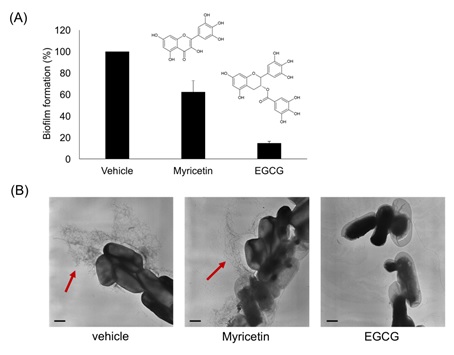
Ken-ichi Arita-Morioka, Kunitoshi Yamanaka, Yoshimitsu Mizunoe, Yoshihiko Tanaka, Teru Ogura & Shinya Sugimoto
Inhibitory effects of Myricetin derivatives on curli-dependent biofilm formation in Escherichia coli
Scientific Reports 8:8452 (2018)
Biofilms are well-organised communities of microbes embedded in a self-produced extracellular matrix (e.g., curli amyloid fibers) and are associated with chronic infections. Therefore, development of antibiofilm drugs is important to combat with these infections. Previously, we found that flavonol Myricetin inhibits curli-dependent biofilm formation by Escherichia coli (IC50 = 46.2 μM). In this study, we tested activities of seven Myricetin-derivatives to inhibit biofilm formation by E. coli K-12 in liquid culture. Among them, only Epigallocatechin gallate (EGCG), a major catechin in green tea, inhibited biofilm formation of K-12 (IC50 = 5.9 μM) more efficiently than Myricetin (Fig. A). Transmission electron microscopy and immunoblotting analyses demonstrated that EGCG prevented curli production by suppressing the expression of curli-related proteins (Fig. B). Quantitative RT-PCR analysis revealed that the transcripts of csgA, csgB, and csgD were significantly reduced in the presence of EGCG. Interestingly, the cellular level of RpoS, a stationary-phase specific alternative sigma factor, was reduced in the presence of EGCG, whereas the rpoS transcript was not affected. Antibiotic-chase experiments and genetic analyses revealed that EGCG accelerated RpoS degradation by ATP-dependent protease ClpXP in combination with its adaptor RssB. Collectively, these results provide significant insights into the development of drugs to treat chronic biofilm-associated infections.

Fig. EGCG decreases curli production leading to reduction of biofilm formation.
(A) EGCG inhibits biofilm formation of E. coli more effectively than Myricetin.
(B) EGCG shows the reduction of curli (red arrow) production. Scale bars, 500 nm.
The concentration of EGCG and Myricetin was 20 μM.